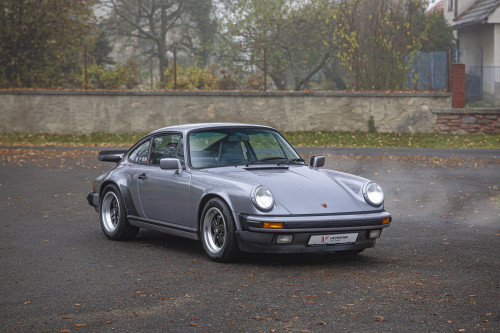The Jaguar XK120 is a roadster sports car manufactured by Jaguar between 1948 and 1954. It was Jaguar's first sports car since SS 100 production ended in 1939. The XK120 is a highly desirable model.
The "120" in the name referred to the 120 mph (193 km/h) top speed, which made it the world's fastest production car at the time of its launch.
This 1951 Jaguar XK120 roadster is a running car that was reportedly purchased by the previous seller’s father in the early 1960s and subsequently acquired by the previous seller in 1975. It is finished in metallic red/copper over white upholstery and is powered by a numbers-matching 3.4-liter inline-six paired with a four-speed manual transmission. Equipment includes a black soft top, red-finished 16″ steel wheels with bright hubcaps, a split windshield, a roll bar, and chrome dash trim. Service performed in 2022 reportedly involved chassis lubrication and fluid flushes.
Originally finished in Bronze with a tan soft top, the car was repainted in its current shade of metallic red/copper during previous ownership and shows wear throughout, including cracking and missing paint, an indentation in the driver-side fender, and a crack in the windshield. Exterior details include a black soft top, a split windshield, an XK140 grille, fender-mounted front indicators, vent doors in each fender, and bright-finished trim. Corrosion is noted beneath the door sills.
Red-finished 16″ steel wheels wear polished Jaguar-branded hubcaps. The master cylinder and brake hoses have been replaced during current ownership.
The interior features seats trimmed in white upholstery along with red carpets. A removable roll bar is positioned behind the cabin, and amenities include a dash-mounted rearview mirror and a passenger-side grab handle. Wear is visible on the seat coverings.
A black-rimmed steering wheel with red spokes fronts a chrome-trimmed dash panel that houses a Smiths 140-mph speedometer, reverse-sweep 6k-rpm tachometer, and auxiliary gauges. The five-digit odometer indicates just under 31k miles. True mileage is unknown.
The 3.4-liter inline-six is equipped with dual SU carburetors and was rated at 160 horsepower. The seller states that the fluids were flushed in recently.
The stamping on the engine block (W3695-8) matches the serial number indicated on the car’s data plate and the correspondence from Jaguar (in the gallery). The same sequence is stamped into the cylinder head, and additional component markings are pictured in the gallery.
Power is sent to the rear wheels via a four-speed manual gearbox. The chassis was reportedly lubricated in 2020, and corrosion is noted on various underside surfaces.
Correspondence from Jaguar details drivetrain, body, and chassis serial numbers as well as factory colors, a manufacturer date, and a September 24, 1951 dispatch date to New York by Max Hoffman.
| Production date | 18.09.1951 |
|---|---|
| Body Type | Roadster |
| Engine | 3.442 ccm, 162 PS, I6 |
| transmission | Manual |
| Steering | Left Hand Drive |
|---|---|
| Layout | Rear Wheel Drive |
| Color - exterior | Copper metallic |
| Color - interior | White / Red |
| Miles/Kilometers shown | 30.554 mls |
|---|---|
| Chassis / VIN | 671578 |
| Location - Country | Czechia |
| Location - City | Hradec Kralove |
2-door roadster body type; RWD (rear-wheel drive), manual 4-speed gearbox; gasoline (petrol) engine with displacement: 3442 cm3, advertised power: 119 kW / 160 hp / 162 PS (max), torque: 264 Nm; characteristic dimensions: outside length: 4394 mm, width: 1562 mm, wheelbase: 2591 mm; reference weights: base curb weight: 1295 kg; top speed: 188 km/h (117 mph) (theoretical); accelerations: 0-60 mph 8.9 s; 0-100 km/h 9.5 s

Písek, Czechia

Písek, CZ

Písek, CZ

Písek, CZ

Písek, CZ

Písek, CZ